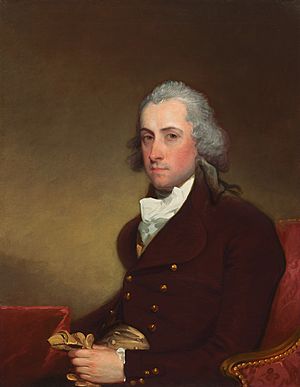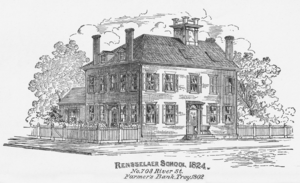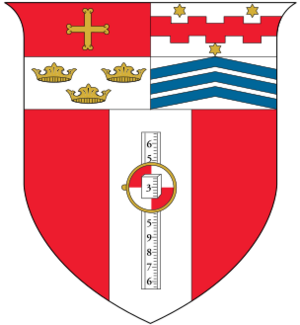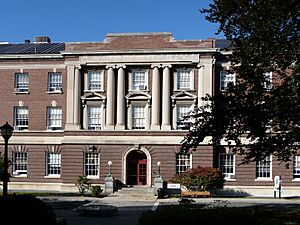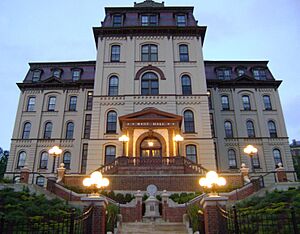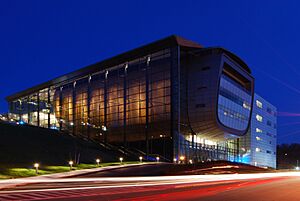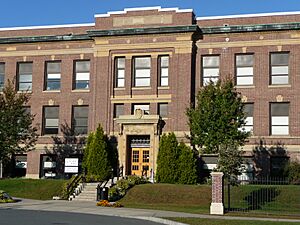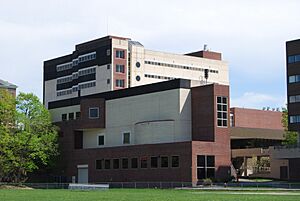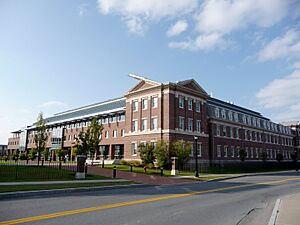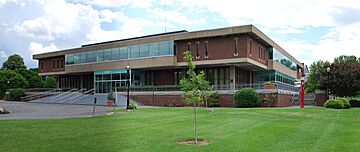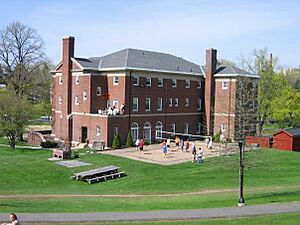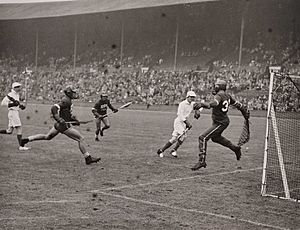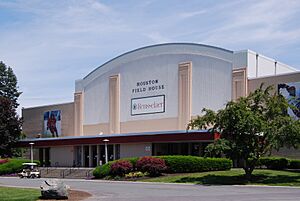Rensselaer Polytechnic Institute facts for kids
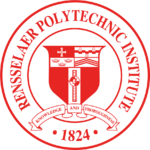 |
|
|
Former names
|
Rensselaer School (1824–1834) Rensselaer Institute (1834–1861) |
|---|---|
| Motto | "Knowledge and Thoroughness" |
| Type | Private research university |
| Established | November 5, 1824 |
| Accreditation | MSCHE |
|
Academic affiliations
|
|
| Endowment | $864 million (2022) |
| President | Martin A. Schmidt |
| Provost | Rebecca W. Doerge |
|
Academic staff
|
488 (2019) |
|
Administrative staff
|
1,291 (2019) |
| Students | 8,142 (2019) |
| Undergraduates | 6,203 (2019) |
| Postgraduates | 1,366 (2019) |
|
Other students
|
573 (2019) |
| Location |
,
,
United States
42°43′48″N 73°40′39″W / 42.7300°N 73.6775°W |
| Campus | Small city, 265 acres (107 ha) |
| Other campuses | |
| Newspaper | The Rensselaer Polytechnic |
| Colors | Cherry and white |
| Nickname | Engineers |
|
Sporting affiliations
|
|
| Mascot |
|
Rensselaer Polytechnic Institute (RPI) is a private research university in Troy, New York, United States. It is the oldest technological university in the English-speaking world. It was started in 1824 by Stephen Van Rensselaer and Amos Eaton. They wanted to teach how to use science for everyday life.
RPI's campus is on a hillside, covering about 265 acres. It looks over the city of Troy and the Hudson River. The university also has a business incubator and a large technology park. RPI focuses on science and technology, with 37 departments across six main schools.
Contents
Discovering RPI's History
Early Years: 1824–1900
Stephen Van Rensselaer opened the Rensselaer School on November 5, 1824. He asked Samuel Blatchford to be the first president. Amos Eaton was the first senior professor. The school opened on January 5, 1825, in Troy. Students came from far away because of Eaton's good reputation. New York State officially recognized the school in 1826. In its early days, the school was more like a graduate school.
Under Eaton, the school became a lively place for technology research. It was renamed Rensselaer Institute in 1832. In 1835, it gave out the first civil engineering degrees in the United States. Many famous civil engineers of that time studied here. Joseph Henry and Thomas Davenport, who sold the world's first working electric motor to the institute, were important visitors.
In 1847, alumnus Benjamin Franklin Greene became the new senior professor. He studied European technical schools to make Rensselaer better. In 1850, he changed the school into a three-year polytechnic institute. In 1861, its name became Rensselaer Polytechnic Institute. A big fire in Troy in 1862 destroyed many buildings, including the institute's. Columbia University suggested RPI move to New York City, but the idea was rejected. The campus then moved from downtown to the hillside.
One of the first Latino student groups in the U.S. started at RPI in 1890. It was called the Club Hispano Americano.
RPI's Growth: Since 1900
In 1904, another fire destroyed RPI's main building. But RPI grew a lot under President Palmer C. Ricketts. He became president in 1901. Ricketts added new departments like Arts, Science, and Business Administration. He also started the Graduate School. He made RPI a true polytechnic institute. The number of degrees offered increased from two to twelve. These included electrical engineering, mechanical engineering, biology, chemistry, and physics. Student numbers grew from about 200 in 1900 to 1,700 in 1930.
After World War II, RPI expanded again. Many veterans used their GI Bill benefits to attend college. The "Freshman Hill" dorms opened in 1953. More dorms and a dining hall were built later. In 1966, Herta Regina Leng became RPI's first female full professor. She is now honored with an annual lecture series. In 1961, the Gaerttner Linear Accelerator was built. It was the most powerful in the world at that time. The Jonsson-Rowland Science Center also opened. The current Student Union building opened in 1967.
The next 30 years brought more growth and new buildings. RPI also formed stronger ties with industries. The "H-building" became home to RPI's incubator program. This was the first program of its kind sponsored only by a university. RPI then invested in land south of campus to create the Rensselaer Technology Park. In 1982, New York State gave RPI $30 million. This was to build the George M. Low Center for Industrial Innovation. It is a center for research funded by industries.
In 1999, RPI was one of the first universities to require students to have a laptop computer. This was also when Shirley Ann Jackson became the eighteenth president of RPI. She started "The Rensselaer Plan" to make the institute even better. Many improvements happened under this plan.
On October 3, 2008, RPI opened the $220 million Experimental Media and Performing Arts Center. Campus construction continued. The $92 million East Campus Athletic Village was completed. A new residence hall, Blitman Commons, also opened in 2009. By 2015, all staff positions had been brought back. Rensselaer also saw significant growth. In 2022, Rensselaer welcomed its largest class ever, with 2,110 students.
In July 2022, Martin A. Schmidt became RPI's nineteenth president.
Exploring the Campus
RPI's 275-acre campus is on a hill. It overlooks Troy and the Hudson River. The campus is divided by 15th Street. Most athletic and housing buildings are to the east. Academic buildings are to the west. A footbridge connects the two sides. Many buildings on campus are in the Colonial Revival style.
Early Campus Buildings: 1824–1905
RPI first started in downtown Troy. Over time, it moved to the hilltop. One building from this period is Winslow Chemical Laboratory. It is on the National Register of Historic Places. It is at the base of the hill and now holds the Social and Behavioral Research Laboratory.
Ricketts Campus: 1906–1935
President Palmer Ricketts oversaw the building of many "Green Rooftop" Colonial Revival buildings. These give the campus its special look. Buildings from this time include the Carnegie Building (1906) and Russell Sage Laboratory (1909). The Quadrangle Dormitories were built from 1916 to 1927. "The Approach" (1907) is a large granite staircase. It connects the city to the university.
Post-War Growth: 1946–1960
After World War II, the campus grew a lot. Nine dorms were built on "Freshman Hill." The Houston Field House (1949) was moved in pieces from Rhode Island and put back together. West Hall was originally a hospital built in 1869. RPI bought it in 1953. It is a beautiful example of French Second Empire architecture.
The Voorhees Computing Center (VCC) is another unique building. It was a seminary chapel built in 1933. RPI bought it in 1958. After changes, it was the institute's library until 1976. In 1979, it was renovated to hold computer labs. Today, the VCC is important for the institute's data and phone systems.
Modern Campus: Since 1961
The modern campus has many buildings. These include the Jonsson-Rowland Science Center (1961) and the Rensselaer Union (1967). The Jonsson Engineering Center (1977) and the Low Center for Industrial Innovation (1987) are also here. Tunnels connect some of these buildings. Barton Hall, a tenth dorm, was added to Freshman Hill in 2000. It has the largest rooms for freshmen.
On October 3, 2008, the university opened the Experimental Media and Performing Arts Center (EMPAC). This building is on the edge of the hill. It has a 1,200-seat concert hall and a 400-seat theater. The building is mostly glass. EMPAC cost over $200 million to build.
In 2008, RPI bought the former Rensselaer Best Western Inn. It was turned into a new residence hall. It opened on May 15, 2009, as the Howard N. Blitman, P.E. '50 Residence Commons. It houses about 300 students. This new hall helps connect students with the Troy community. RPI also owns other office buildings in downtown Troy.
Other Campuses and Online Learning
RPI used to have a campus in Hartford, Connecticut. It also had a distance learning center in Groton, Connecticut, which closed in 2018. The Hartford campus was sold in 2023. Now, these programs are managed by Rensselaer at Work. This online branch offers graduate degrees and training for working professionals.
Learning at RPI
Rensselaer Polytechnic Institute has five main schools:
- School of Architecture
- School of Engineering
- School of Humanities, Arts, and Social Sciences
- Lally School of Management & Technology
- School of Science
The School of Engineering has the most students. RPI offers over 145 programs in nearly 60 fields. These lead to bachelor's, master's, and doctoral degrees. RPI also has special programs like Games and Simulation Arts and Sciences. Since 1999, all new freshmen have needed a laptop computer.
The Rensselaer Plan
When President Shirley Ann Jackson arrived in 1999, she announced "The Rensselaer Plan." Its goal was to make Rensselaer a more famous technology research university. The plan aimed to bring in more graduate students and new research faculty. It also wanted more students to do undergraduate research and international exchange programs. New buildings like the Center for Biotechnology and Interdisciplinary Studies and EMPAC were built. Application numbers also increased. In 2018, Rensselaer received a record 20,337 applications.
The university aimed to raise $100 million annually for research. By 2013, it reached this goal. RPI also started a $1 billion fundraising campaign. In 2001, an anonymous donor gave $360 million. This was one of the largest gifts to a U.S. university at the time. By 2006, the $1 billion goal was passed. This was partly due to a large software donation. The goal was then increased to $1.4 billion and met by October 2008.
An updated plan, "Rensselaer Plan 2024," was announced in 2012. In 2016, Jackson announced a new $1 billion fundraising campaign. This campaign aimed to support financial aid for students and expand research facilities.
Rankings and Recognition
Rensselaer is often ranked among the top universities. For 2021, U.S. News & World Report ranked Rensselaer tied for 53rd among national universities in the U.S. Its undergraduate engineering program was tied at 32nd.
In 2024, Washington Monthly ranked RPI 117th among national universities. This ranking looks at how universities help the public good. In 2016, The Economist ranked Rensselaer No. 18 among four-year colleges.
Electrical and Computer Systems Engineering
The Electrical and Computer Systems Engineering (ECSE) department is a major part of RPI. Students can earn bachelor's, master's, and doctoral degrees here. Electrical Engineering was first taught at RPI in 1907. Computer Systems Engineering was added later. Electrical Engineering focuses more on hardware. Computer Systems Engineering focuses on algorithms and systems. Many students choose to study both.
The ECSE department does research in many areas. These include information science, communication networks, and computer systems design. Many famous people have graduated from this department. These include Marcian Hoff, who created the microprocessor, and Raymond Tomlinson, who invented e-mail. Steven Sasson invented the digital camera. Curtis Priem designed the first graphics processor for PCs and co-founded NVIDIA.
Research and Innovation
Rensselaer is known for its very high research activity. It focuses on six main research areas:
- Biotechnology
- Energy and the environment
- Nanotechnology
- Computation and information technology
- Media and the arts
Research is managed by the Office of the Vice President for Research. In 2018, Rensselaer had 34 research centers. It spent $100.8 million on sponsored research.
The Center for Biotechnology and Interdisciplinary Studies is a large research facility. It focuses on biotechnology research. Its main goal is to understand proteins and genes. This helps in creating new medicines and treatments. The center has produced over 2,000 research papers. It trains many undergraduate and graduate students. Its partnerships have led to new developments in diagnostics and medical devices.
Rensselaer also has the Tetherless World Constellation. This group studies the World Wide Web. They work on future web technologies and data analysis. In 2016, they received a grant from the Bill & Melinda Gates Foundation. This was for a new data visualization platform.
Rensselaer also runs the Center for Computational Innovations. This center is a $100 million project with IBM and New York State. It has one of the most powerful private-university supercomputers in the world. This supercomputer can do over 1.1 peta-FLOPS. The center helps reduce the cost of developing tiny materials and devices. It also supports research in biotechnology, medicine, and energy. Rensselaer has a nuclear reactor, the only university-run reactor in New York State. It also has the Gaerttner Linear Accelerator.
In 2024, Rensselaer and IBM launched a new quantum computer on campus. This aims to advance quantum computing research.
Student Life at RPI
RPI students have many clubs and organizations. About 170 of these are funded by the Student Union. Another 30, mostly religious or political groups, support themselves. In 2006, Princeton Review ranked RPI second for "more to do on campus." The Union was the last entirely student-run union at a private university until 2017.
Student Organizations
Phalanx is RPI's Senior Honor Society. It started in 1912. It recognizes students who show great leadership and service to the university.
RPI has about 20 intramural sports groups. These are for fun and competition. There are also 39 club sports. The Ski Club and Outing Club are very popular. They offer trips to ski areas and for outdoor activities.
The Rensselaer Polytechnic is the student-run weekly newspaper. It used to print 7,000 copies. In 2018, it switched to online-only. It gets its money from selling ads. Statler & Waldorf is a popular student magazine.
RPI has an improvisational comedy group called Sheer Idiocy. There are also several music groups. These include a cappella groups like the Rusty Pipes and instrumental groups like the orchestra.
WRPI is the campus radio station. It broadcasts to a 75-mile area, including Albany. It has a strong signal, stronger than many other college radio stations.
The RPI Players is a theater group started in 1929. They perform in the 15th Street Lounge. They have put on over 300 plays.
RPI Songs
There are several songs sung at RPI events:
- "The Alma Mater (Here's to Old RPI)" is sung at formal events. The Pep Band plays it at games. The bell tower plays it daily at noon.
- "Hail, Dear Old Rensselaer" was the fight song in the 1960s. The Pep Band still plays it.
- "All We've Learned at Rensselaer" is sung at graduation ceremonies.
First Year Experience and CLASS Programs
The "First-Year Experience" (FYE) program is important at RPI. Freshmen start with "Navigating Rensselaer and Beyond" week. The FYE office offers programs for all students. These include family weekend and community service days.
In 2008, the university started the "Clustered Learning Advocacy and Support for Students" (CLASS) program. This program requires sophomores to live on campus.
NROTC
RPI has a Naval Reserve Officers Training Corps (NROTC) program. It trains students to become officers in the United States Navy and Marine Corps. The program started at RPI in September 1941. It helped train officers during World War II.
Since 1926, over 75 Naval Officers with RPI degrees have become flag officers. This is a large number for one institute, besides the U.S. Naval Academy. Notable alumni include NASA Astronaut CDR Reid Wiseman and RDML Lewis Combs. RDML Combs founded the Navy Construction Battalion, known as the "Seabees."
Grand Marshal and President of the Union
The Grand Marshal (GM) and President of the Union (PU) are student leaders elected by students. The GM position has been at RPI since 1865. The PU position started in 1890. The week of voting for these positions is called GM Week.
The Grand Marshal is the highest student position at RPI. The GM works on projects and helps the campus community. The first GM was Albert M. Harper.
The President of the Union is also elected by students. Their main job is to appoint an executive board of 15–20 students. This board manages the Rensselaer Union's budget. The first PU was W.C.H. Slagle.
Greek Life
Rensselaer Polytechnic Institute has a long history of Greek organizations. These groups focus on leadership and community service. RPI has 29 active fraternities and 6 sororities. About 32% of males and 18% of females are involved.
Three Greek organizations were founded at Rensselaer:
- Theta Xi (a national engineering fraternity)
- Sigma Delta (a Hispanic-interest sorority)
- Rensselaer Society of Engineers (a local engineering fraternity)
Theta Xi was founded on April 29, 1864, during the Civil War. Its chapter house is on the National Register of Historic Places. RPI is also home to the Alpha Phi Omega (APO) service fraternity. APO runs a test-bank and a public 3D printing service.
Greek organizations often do charity events. In 2017, Chi Phi and Theta Chi co-hosted "Brave A Shave For Kids With Cancer." They raised over $22,000 for pediatric cancer research. Many groups also participate in Adopt-a-Highway programs. They host events for new students, like Beach Day/Hike with Greek Life.
Student Body Overview
In 2018, Rensselaer had 7,442 students. This included 6,590 undergraduate and 1,329 graduate students. Over 71% of students came from out of state. More than 20% were international students. RPI students come from all 50 U.S. states and over 60 countries. There are 13 students for every faculty member.
For the class of 2020, 66% of students were in the top 5% of their high school class. The average high school GPA was 3.88. The average SAT score was between 1330 and 1500. The average ACT score was between 29 and 33. In 2016, 94% of freshmen returned for their second year.
About 12% of students received the Rensselaer medal. This is a scholarship worth $100,000 for high school students good at science and math. Most full-time undergraduate students receive financial aid. In 2018, Rensselaer spent over $140 million on financial aid.
Gender Ratio
RPI started allowing women in 1942. In 1966, there were 19 men for every woman. By 2009, the ratio was 2.5 men to 1 woman (72% male / 28% female). In 2016, the ratio for new freshmen was 2.1 men to 1 woman (68% male / 32% female). This was the lowest in the institute's history. In fall 2016, over 1,000 women enrolled in RPI's engineering programs. They made up 30% of engineering students and 32% of all students. The dean of engineering wants to reach 50% female students by 2030.
RPI Athletics
The RPI Engineers are the university's sports teams. RPI has 23 sports. Most compete in NCAA Division III in the Liberty League. Men's and women's ice hockey teams compete at the Division I level in ECAC Hockey. The official nickname for all teams is the Engineers. The ice hockey mascot, Puckman, is very popular. He is a hockey puck with an engineer's helmet.
A popular RPI cheer from the 1970s and 1980s goes:
- E to the x, dy/dx, E to the x, dx
- Cosine, secant, tangent, sine
- 3.14159
- Square root, cube root, log of pi
- Disintegrate them, RPI!
Men's Ice Hockey
RPI Engineers men's ice hockey RPI has a strong Division I hockey team. They won NCAA national titles in 1954 and 1985. In the 1984–85 season, they were undefeated for 30 games. This streak continued for 38 games into the 1985–86 season. Adam Oates and Daren Puppa, who played then, became stars in the NHL. Joé Juneau and Brian Pothier also played many years in the NHL.
The hockey team is very important to campus culture. Thousands of fans come to the Houston Field House each week. Students even line up for season tickets months in advance. Since 1978, there has been a "Big Red Freakout!" game in February. Fans wear red and white, and gifts are given out. RPI's biggest hockey rival is Clarkson University. They also have a rivalry with Union College.
Women's Ice Hockey
RPI Engineers women's ice hockey The women's ice hockey team moved to NCAA Division I in 2005. In the 2008–09 season, they won a record 19 games. On February 28, 2010, Rensselaer made NCAA history. They beat Quinnipiac 2–1 in five overtimes. This was the longest game in NCAA Women's Ice Hockey history.
Men's Lacrosse
The lacrosse team represented the United States in the 1948 Olympics in London. They won the national collegiate championship in 1952. Ned Harkness coached both the lacrosse and ice hockey teams, winning national titles in both.
Baseball
The Engineers baseball team is often at the top of the Liberty League. Eight players have gone on to play professionally. The team plays its home games at the historic Robison Field.
American Football
Intercollegiate football started at RPI in 1886. RPI first played Union College then. Since 1903, RPI and Union have been football rivals. This is the oldest rivalry in New York State. They play for the Dutchman's Shoes trophy since 1950. RPI Football had its best season in 2003. They finished 11–2 and reached the NCAA Division III semifinal game.
Athletic Facilities
The Houston Field House is a 4,780-seat arena on the RPI campus. It opened in 1949. It is home to the RPI Engineers men's and women's ice hockey teams. The Field House was renovated starting in 2007. This was part of a big campus improvement project. Renovations included new locker rooms and a weight room. Solar panels were installed on the roof to power the building.
RPI also completed a major project to improve its athletic facilities. This was called the East Campus Athletic Village. It included a new 4,842-seat football stadium. It also has a basketball arena, a new 50-meter pool, and an indoor track. The project cost about $78 million for the first phase. The old football field on the central campus is now an open space.
History of Women at RPI
Rensselaer Polytechnic Institute was mostly for men for a long time. The first woman applied in 1873, Elizabeth R. Bruswell. But she did not attend because she would have been the only woman. Women were not allowed to enroll in classes until 1942.
First Women at RPI
Students
Camilla Cluett, Elizabeth English, Helen Ketchum, Lois Graham, and Mary Ellen Rathbun were the first women to enroll in 1942. Lois Graham and Mary Ellen Rathbun were the first to graduate on April 22, 1945. Antoinette A. Patti was the first woman to get a master's degree in 1947. Reva R. G. Servoss was the first woman to get a doctoral degree in 1954.
Faculty
Miss Hazel Brennan was the first woman assistant instructor in chemistry in 1918. Marie De Pierpont was hired as a French instructor in 1919. She became a full professor and head of the language department in 1928. She was the first woman to hold a full professorship. Herta Regina Leng became a full professor in physics in 1966.
The percentage of women at RPI has improved a lot. As of 2020, about 32% of students were women and 68% were men.
Notable Alumni
RPI has nearly 100,000 graduates living in the United States and abroad. In 1995, the Alumni Association created the Rensselaer Alumni Hall of Fame.
Many famous 19th-century civil engineers graduated from RPI. These include Theodore Judah, who helped plan the transcontinental railroad. Washington Roebling was the engineer for the Brooklyn Bridge. George Washington Gale Ferris Jr. designed and built the first Ferris Wheel.
Many RPI graduates have made important inventions:
- Allen B. DuMont ('24) created the first commercial television and radar.
- Keith D. Millis ('38) invented ductile iron.
- Ted Hoff ('58) is known as the father of the microprocessor.
- Raymond Tomlinson ('63) is often credited with inventing e-mail.
- Steven Sasson invented the digital camera.
- Curtis Priem ('82) designed the first graphics processor for PCs and co-founded NVIDIA.
RPI graduates have also started major companies like John Wiley and Sons, Texas Instruments, and Garmin. Several RPI graduates have been part of the U.S. space program. These include George Low, who managed the Apollo 11 project, and astronauts John L. Swigert Jr., Richard Mastracchio, and Gregory R. Wiseman. Space tourist Dennis Tito is also an alumnus.
Political figures who graduated from RPI include federal judge Arthur J. Gajarsa (B.S. 1962). Prime Minister Hani Al-Mulki of Jordan also attended RPI.
Notable ice hockey players include NHL Hockey Hall of Famer Adam Oates (1985). Stanley Cup winner Mike McPhee (1982) is also an alumnus.
Other notable alumni include Nobel Prize in Physics winner Ivar Giaever (Ph.D. 1964). Lois Graham (B.S.ME 1946) was the first woman to get an engineering degree from RPI. She was also the first woman in the U.S. to get a PhD in engineering. David Ferrucci was the lead researcher on IBM's Watson/Jeopardy! project. Director Bobby Farrelly (1981) also graduated from RPI.
See also
 In Spanish: Instituto Politécnico Rensselaer para niños
In Spanish: Instituto Politécnico Rensselaer para niños
- Association of Independent Technological Universities


